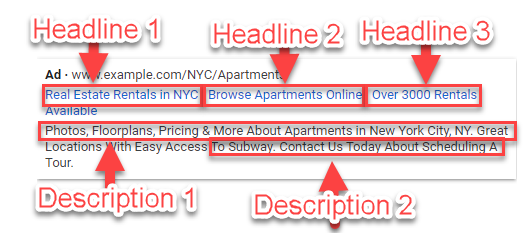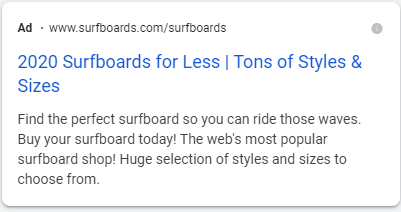Update on January 28, 2021, to include current information and insights.
Through pay-per-click marketing, businesses have the opportunity to create highly targeted advertising campaigns in an effort to reach their most valuable customers online. For many businesses that cannot compete in the organic rankings for their most important keywords, paid advertising provides an outlet to get in front of the right customers at the very top of the search results. Oftentimes, those ads are the first time a potential customer sees or hears about your brand. With the importance of making a good first impression on the line, writing great ad copy is crucial to not only introducing your brand messaging and offering to a customer but also enticing them to visit your website.
Looking closer, your pay-per-click marketing ads are the gateway between your potential next customer’s need and the solution your business provides for them. Grabbing their attention, enticing them to your offer, and providing them with the necessary steps to convert all starts with your ad copy.
Regardless of how strong your campaign targeting is or how great your landing pages and conversion funnels are, without engaging ads, your PPC marketing efforts may fall flat.
Writing great ad copy is not easy. Similar to other facets of operating a PPC account, writing ads requires a balance of technical understanding and ambiguous business understanding.
Anatomy of a PPC Ad
Before getting into the nitty-gritty of how to write great ad copy, it’s important to understand the anatomy of a PPC ad. It’s not uncommon for ad specifications and requirements to differ by advertising platform, so for this exercise, we’re going to focus on Google Ads.
At the most fundamental level, PPC ads on Google Ads can be broken down into five different pieces. Let’s take a look:
- The Headline: limited to 30 characters, the headline is typically the first piece of your ad a user will see. Aligning your headline with the keywords in your ad group and landing page can provide the best chance for Quality Score success. You can include up to three headlines in an ad.
- Description Line 1: with 90 characters allowed in your first description line, advertisers have the opportunity to promote their offerings.
- Description Line 2: a second 90 character parameter allows for advertisers to build on their first description line or add a call-to-action for the user.
- The Display URL: the display URL is the URL users will see when viewing your ad. It is not necessarily the URL visitors will be taken to after clicking your ad. This is used if the actual URL looks cluttered, has a bunch of numbers in it, or just doesn’t look visually appealing. Display URLs clean this up in a simple, easy to read URL so the user knows exactly where the link will take them.
- The Final URL: not visible to users, the final URL has no character limit and represents the URL visitors will be taken to after clicking your ads.

Visual Formatting of a PPC Ad
On Google search engine result pages (SERPs), ad components are mixed and matched in a number of different formats as Google tries to find the highest performing combination. That said, it’s important to provide content that ensures proper ad copywriting and formatting. We’ll dive into that shortly, but first, let’s look at the standard way google is formatting their Search Network ads.
Here’s a look at a commonly formatted PPC ad in the SERP:

While three headlines were input when editing the ad, because Google often tests and tweaks their ad layouts over time you won’t always see all of your headlines and/or ad extensions on the SERP. And despite the formatting changes advertisers can’t control, Google’s ad requirements, and in-turn best practices for writing great ad copy, have stayed constant over time.
Best Practices For Writing PPC Ad Copy
By following these six simple recommendations, set yourself up to start writing great PPC ad copy today.
1. Be Relevant
First and foremost, if you want your potential customers to pay attention to your ads, they need to be of interest to them and relevant to their needs. Much of the ad relevance battle can be won or lost through the creation of your PPC advertising campaigns and ad groups. Ensuring your campaign structure is set up in an optimized fashion is vital for relevancy success. Check out this post from Portent’s Ryan Moothart to learn more about how to structure your campaigns.
However, your ad copy is also extremely important in gaining relevance with potential customers. Your ads should match the keyword theme in that corresponding ad group and the keyword/ad copy you’re using should match the landing page users are directed to after clicking an ad. If your ad contains keywords matching the user’s search query, those keywords in your ad will appear bolded in the search results leading to higher click-through rates. The more your ad matches the searcher’s intent, the more likely they are to click through to your website.
2. Stay Concise
With the character limits outlined above, advertisers don’t have much room for long, drawn out messaging in their PPC ads. As a result, these limits can leave little room for creativity. The key here is to be concise and to the point. Doing so will help stay on message and within the required character limits. Here is a good example of using concise language in ads:

3. Use a Unique Value Proposition
After grabbing your next customer’s attention with your headline, use a unique value proposition to help your offer stand out from the competition. How can your product or service provide a solution for a potential customer’s problem or need? Why should someone buy your product or use your service over the competition? What makes you better than the other advertisers you’re displayed with?
Using a UVP helps you stand out from the rest.
4. Guide With a Call-to-Action
Once you’ve enticed a potential customer with what makes you better than the rest, it’s time to tell them what you want them to do after getting to your site. That’s where a call-to-action (CTA) around a conversion point comes into play. Implementing a CTA into your ad copy is a great way to drive click-through and conversion rates. Examples of CTAs could be:
- Buy Now
- Shop Today
- Contact Us
- Sign Up

Using phrases like these will help guide your visitors to your conversion point once they get to your landing page.
5. Use Title Case and Proper Punctuation
In addition to actual words and content within your text ad, formatting and punctuation are very important. If you don’t have correct punctuation or formatting, it can make the ad harder to read for the user while also undercutting your credibility as a company. We recommend using title case to write every headline while using normal capitalization in the descriptions. Here are a couple of examples:
- 60% Off All Surfboards Today!
- Contact Us Today for a Free Guide.
Additionally, we recommend finishing each description line with proper punctuation. Doing so ensures strong readability, regardless of how Google chooses to display your ad. Punctuation should be used in both description lines but not the headline of your ad, per Google editorial guidelines.
6. Try Experimenting!
Test, test, test! Writing great ad copy doesn’t always happen on your first try. By implementing ad tests you can see what resonates and what doesn’t with your customers. Continuing to test to find what works best is how you continue to find and write great PPC ads as your account management continues.
Ready to write great ad copy? Awesome! Understanding and using these six keys will help guide you as you go.









